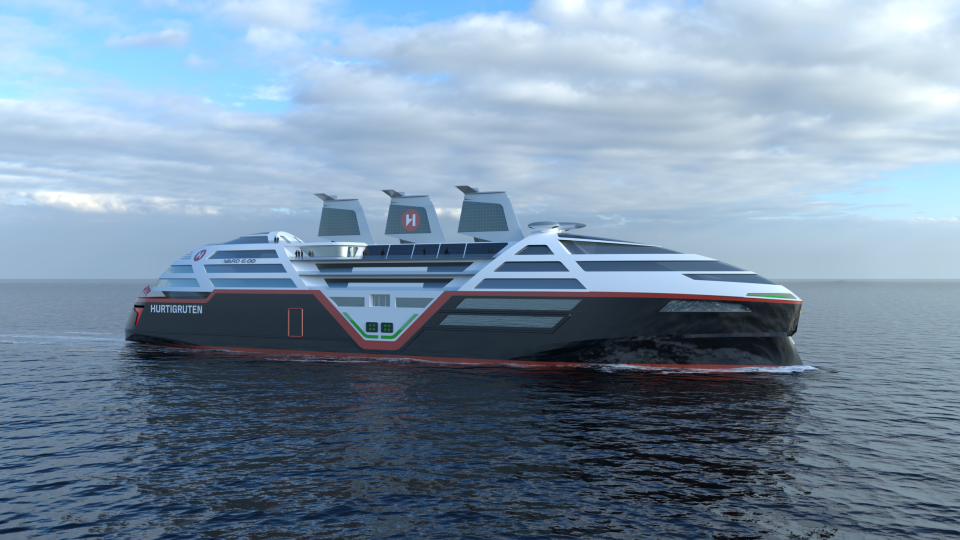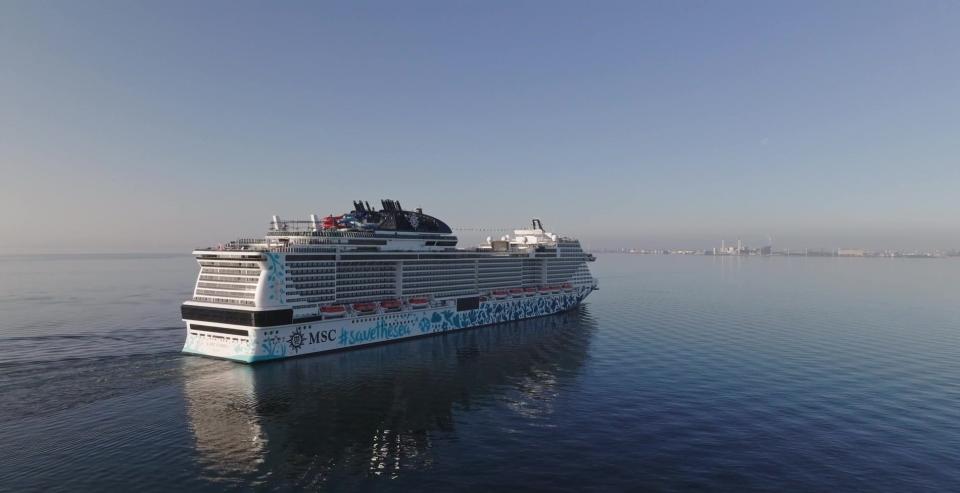Can we have eco-friendly cruising? What to know about zero-emission ships.
Imagine taking a cruise along the coast of Norway and stepping into the open air to see snow-covered peaks set to a hushed, white-noise soundtrack of lapping waves. If you close your eyes, you'd forget you're on a ship.
That’s part of what specialty cruise line Hurtigruten Norway is aiming for with its proposed “zero-emission” ship, currently scheduled to set sail in 2030.
“That's one of the things I think will be very beneficial with these ships is that they will be very quiet, and that gives you a completely different experience when you're sitting outside,” Gerry Larsson-Fedde, COO for Hurtigruten Norway, told USA TODAY.
The line originally announced the project in 2022, and released details about the ship last month alongside a consortium of 12 maritime partners and research institute SINTEF following a feasibility study.
The vessel is one of multiple possible models for more sustainable sailing that cruise lines have showcased in recent weeks.
What is a 'zero-emission' cruise ship?
Hurtigruten Norway’s ship will be powered by a combination of batteries and retractable sails with solar panels. The line already utilizes batteries on its hybrid-powered ships, but the 60 megawatt-hours (10 times more powerful than the current batteries sailing along the coast) used on the new vessel will represent a major upgrade, according to Larsson-Fedde.
The 500-passenger ship will also feature a more aerodynamic hull at its bow, retractable thrusters at its stern and underwater air lubrication technology – enabling the ship to “surf” on air bubbles – to reduce drag.

During an 11-day sailing, Larsson-Fedde said, the line expects to charge the ship’s battery system in six ports along the way at 10 megawatts per hour. “I mean, with small adjustments to today’s schedule that can be done the way we look at,” he said.
The line chose ports that it believes can provide the amount of power needed, though Larsson-Fedde said infrastructure, including charging stations, will need to be further developed. The 24-hour sunlight parts of the country sees in the summer will also provide the vessel with added juice.
What is a 'net-zero' emissions cruise?
MSC Cruises also announced a major step toward its sustainability goals in recent weeks. The line sailed its first “net-zero” greenhouse gas emissions sailing last month on its new ship, MSC Euribia.
The voyage, which sailed from Saint-Nazaire, France, to Copenhagen, Denmark, between June 3 and 7, utilized bio-LNG via a mass balance system: The company purchased 400 tonnes of the biofuel that went into the European gas grid.
Carbon is absorbed in the production of bio-LNG and returned to the air when the fuel is burned, making it presumably carbon neutral.
Given what Linden Coppell, MSC Cruises’ vice president of sustainability & ESG, called the “bespoke” nature of the fuel, and the fact that it didn’t make sense to transport it across the continent from the Nordic region where it was sourced, the line did not exclusively use bio-LNG on the sailing, though some may have ended up on the ship as well.

“I mean, when we first said, 'We can't put it physically on the ship,' we were all kind of getting our heads around that (and) I thought, 'Well, you know what, this is a really excellent opportunity to show people we've got to think completely differently about how we get fuel, how we account for fuel, how we use fuel, how we how we encourage the market,' ” said Coppell.
Is 'zero-emission' or 'net-zero' cruising too good to be true?
Environmental organization Friends of the Earth released an analysis in April saying cruise passengers emit eight times as much carbon dioxide per day as vacationers on land.
Cruise lines have invested in cleaner-burning liquified natural gas as a “transitional” fuel, and are exploring options including batteries, biofuels and hydrogen, according to Cruise Lines International Association, the industry’s leading trade group (Hurtigruten Norway is not a CLIA member).
When it comes to decarbonizing the marine world, there’s “no silver bullet,” said Matthew Collette, an associate professor of naval architecture and marine engineering at the University of Michigan.
“There are going to be different solutions for different parts of the world (and) different types of ships,” he said.
The kind of ship Hurtigruten Norway plans to operate may work great for short-range cruises, but is not feasible for the kinds of deep-sea cruises many travelers take. There is also existing precedent on a small scale, such as electric ferries in the Nordic country.
But for cruises from Florida to the Caribbean, for instance, batteries would be too heavy and expensive in their current form, and would not be practical for cruising longer than one day – or maybe even less. Higher energy density could make a big difference if increased by 10 or 20 times, Collette said.
Can US-based cruises run on 'zero emission' technology?
Hurtigruten will also benefit from Norway’s existing electricity system, which comes almost entirely from renewable resources. “If you moved it to the U.S. and you plug it into a grid where the energy is not predominantly hydropower, you know, there's natural gas or coal plants or other things producing it, immediately you're not going to be a zero carbon ship anymore,” Colette said.
MSC’s trial voyage on the more than 6,300-passenger Euribia, meanwhile, highlights the “biggest problem” with alternative fuels to the diesel fuel many cruise ships use today, according to Collette: They’re not widely available.
While bio-LNG is presumably carbon neutral, the picture becomes more complicated if you factor in emissions created throughout the process, such as separating the fuel from carbon dioxide, liquifying it and transporting it.
Biofuels have long been controversial, and critics have said competition with food production can impact carbon emissions and undermine the argument for them.
“The bio-LNG purchased by MSC Cruises is sourced entirely from agricultural and municipal waste residues, meaning it has little to no impact on land-use change,” Coppell said. “This is very different from so-called first-generation biofuels that are primarily crop-based."
What happens to cruises' uneaten food?: These lines are working to reduce waste
The sources for the fuel and means of production were also certified by International Sustainability and Carbon Certification, Coppell said. “This ensures a complete and accurate greenhouse gas accounting for the fuel's entire lifecycle, including production, transportation, distribution and end-use,” she added.
How are cruise ships pushing for greener practices?
It’s also not just moving the ship through the water that takes energy. Collette said the majority of power produced on many cruise ships goes toward passenger cabins, restaurants and other features.
Hurtigruten plans to use heat exchange pumps and insulated distribution systems for heating and cooling on its ship, and guests will be able to control energy use in their rooms via a mobile app.
MSC had its own energy-efficiency team on board the June sailing, along with representatives from the Chantiers de l'Atlantique shipyard, and optimized speed profiles, HVAC, lighting and more so the ship never had to use more than two of its four engines. The line also used heat from the engines for hot water rather than its boilers, according to Coppell.
French cruise line Ponant also recently announced its own plans for a ship it said will sail emissions-free, using wind and solar power, as well as fuel cells.
Cruise ships can run for between 20 and 30 years, according to Collette. “So, if we want to be zero carbon by 2050, we're probably making all of our big decisions this decade of how to get there,” he said.
Hurtigruten will spend the next two years doing research and development, followed by other preparations, and plans to start building the ship around 2027. For MSC’s part, Coppell said doing another similar sailing in the immediate future would be cost-prohibitive. While Coppell did not disclose how much the company spent on the bio-LNG, she said it was “a lot.”
“But I think, really, it's now more important for us to do this as a kind of call for action for governments and others just to say, “How can we scale up these fuels and how can we bring them closer to cost parity?”
Nathan Diller is a consumer travel reporter for USA TODAY based in Nashville. You can reach him at ndiller@usatoday.com.
This article originally appeared on USA TODAY: Green travel: What to know about zero-emission cruises

